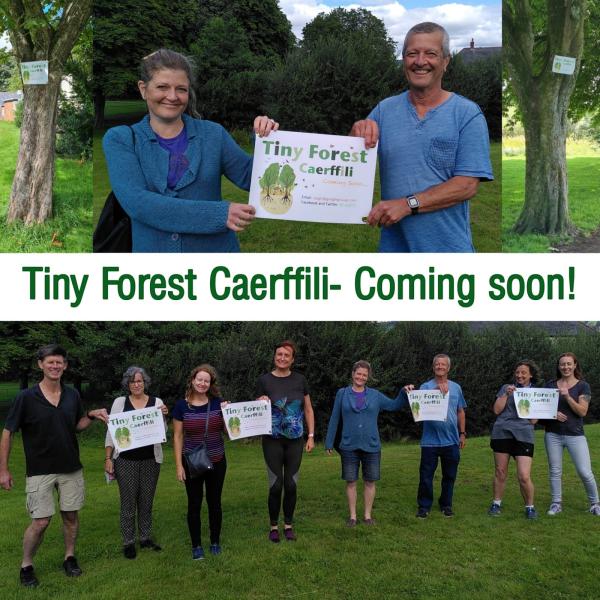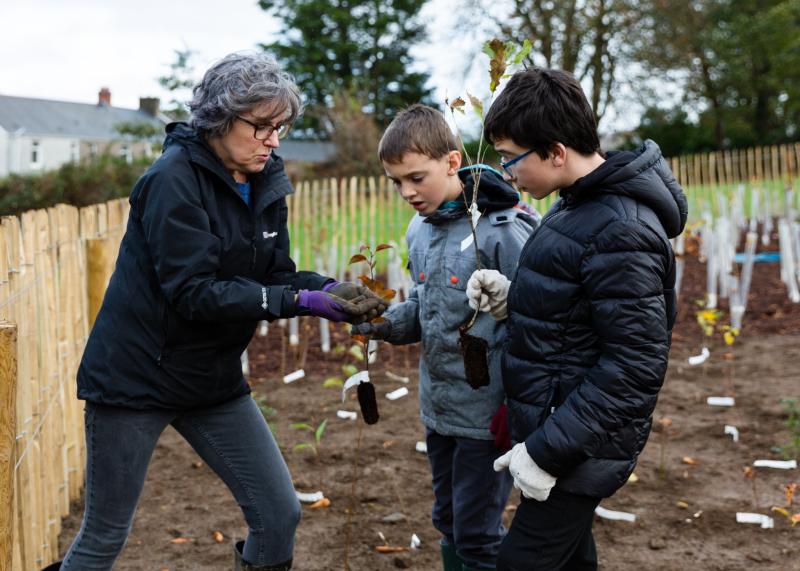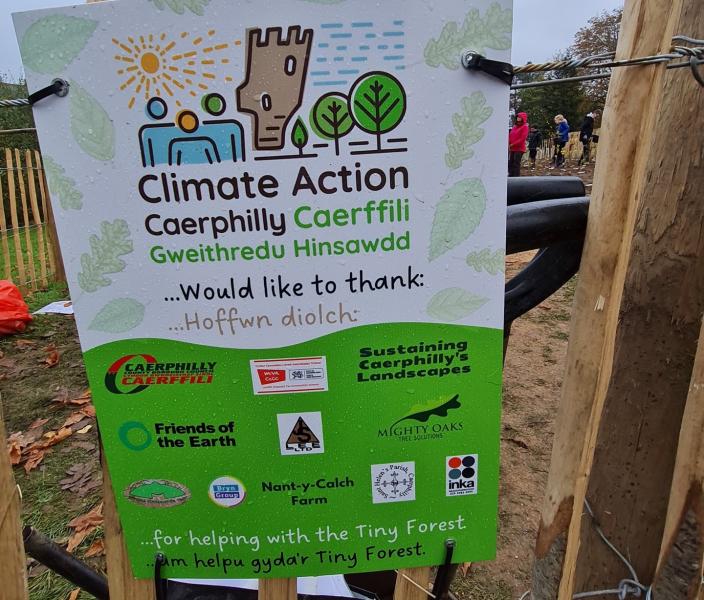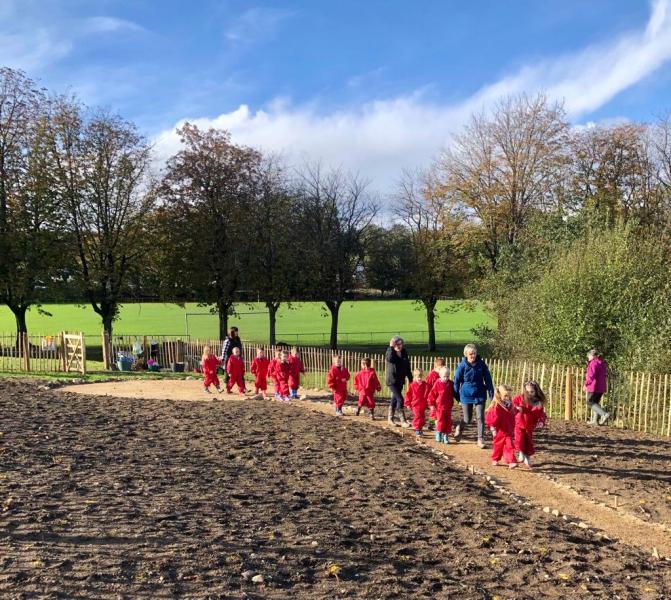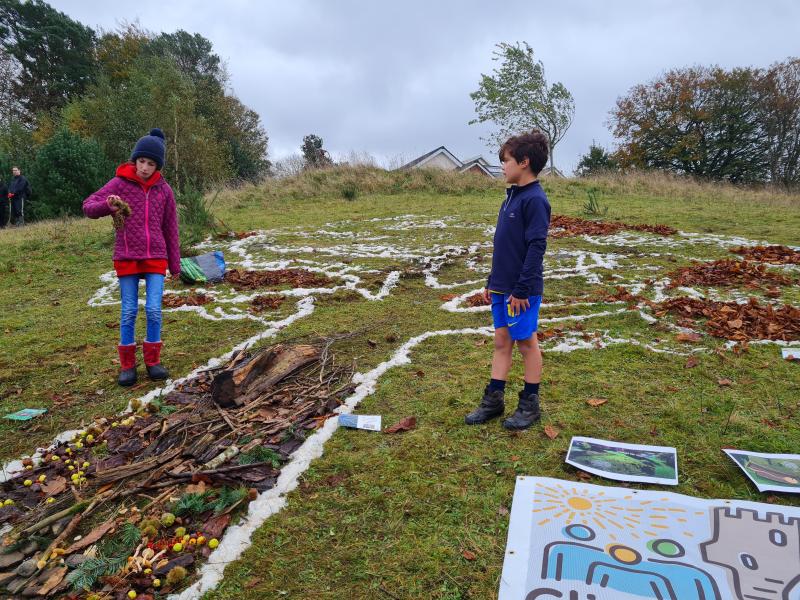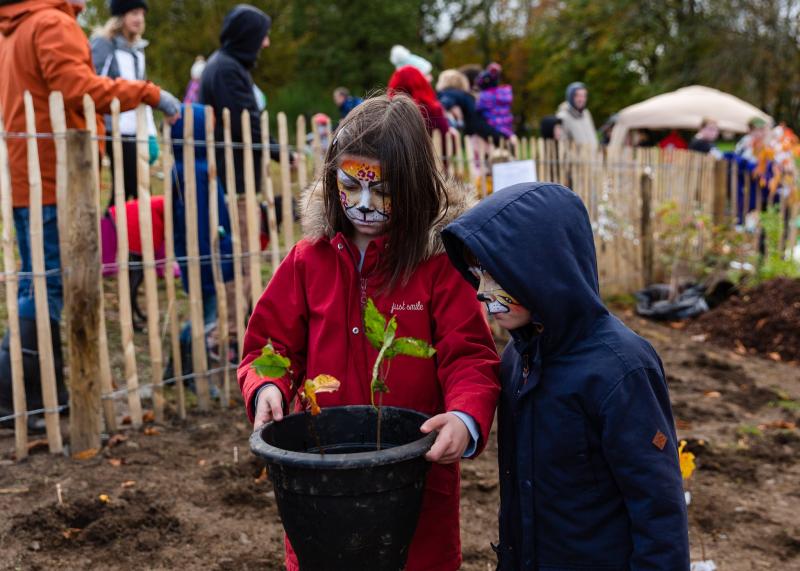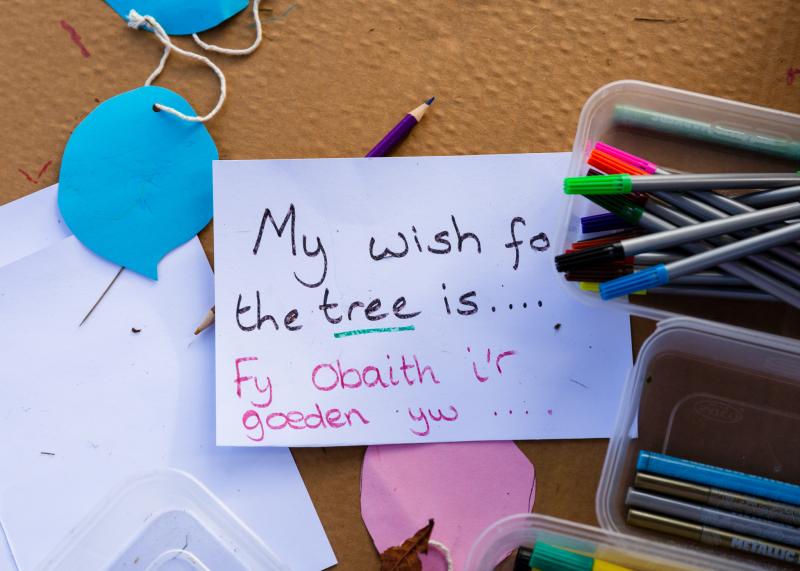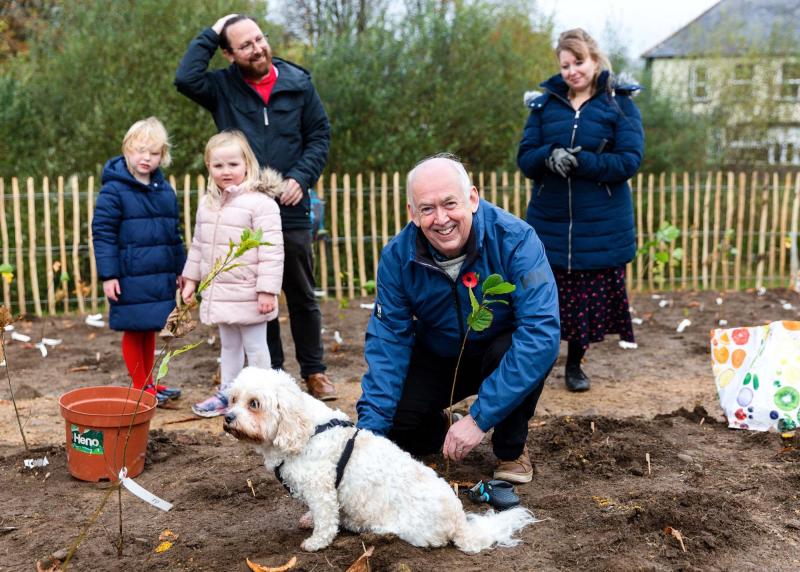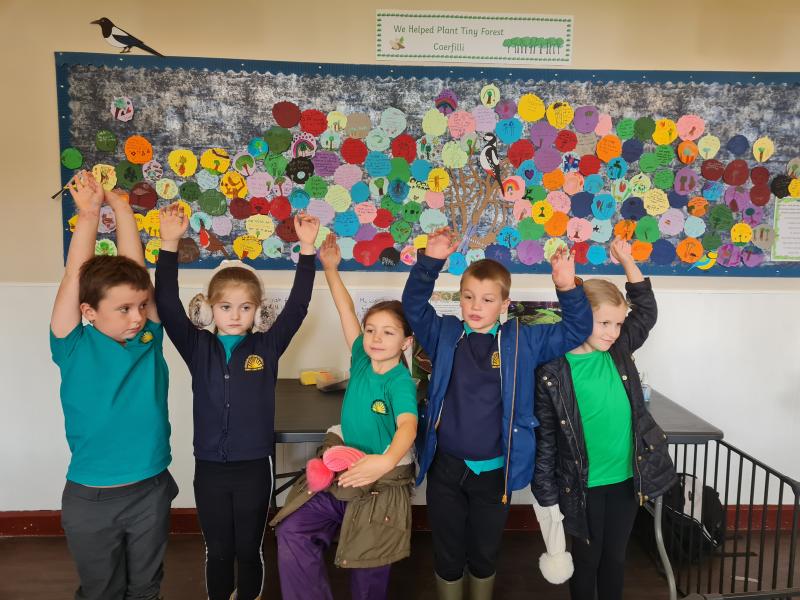Joanna Watson02 Feb 2022
When I first heard a reference to the concept of a Tiny Forest I didn’t know whether it was a collection of miniature trees or a piece of woodland with ideas above its station. That was before I realised that Experiments team colleagues had been in touch with Climate Acton Caerphilly back in 2020 when they were thinking about creating their own Tiny Forest to do their bit for the climate. We had recently explored this approach as part of a ‘sprint’ looking at practical strategies for doubling tree cover and had interviewed one of the pioneers of the methodology in Europe. That meant we were able to share research and learnings and put the group in touch with others trying similar things, such as this project in Bristol.
Such synchronicity is always exciting and I was curious to know what happened once this ambitious project was up and running. A couple of years on, I had an illuminating talk with teacher and environmentalist Lynn Gazal of Climate Action Caerphilly to find out.
Given that the idea had its origins at the start of the pandemic, I was hugely impressed by the time, commitment, energy and very hard work that saw Tiny Forest Caerffili researched, planned and finally planted as part of the Global Day of Action that coincided with the climate talks in Glasgow, November 2021.
As Lynn says “when it all came together in the last week there was a great release of breath. So many things could have gone wrong and we were wondering whether it would happen at all, so we had a real sense of achievement. Seeing it grow from research all the way through was rewarding, especially when you saw how inspired so many young people were. We were amazed by the response from the public”.
So what is a Tiny Forest and why did Climate Action Caerphilly want to create one?
Tiny Forests are based on the principles developed by Japanese botanist Akira Miyawaki, who discovered that planting a densely packed forest, in nutrient rich soil, forces trees to compete for light and grow up to 10 times faster and become up to 20 times more biodiverse than normal forests. They are ideal for small plots of land; can help regeneration, absorb carbon and reduce flooding.
Climate Action Caerphilly was looking for a project that would engage children with a strong educational core, involve the local community - and if successful could have a snowball effect. They wanted a project that would not only teach kids about Climate Change, but could be effective in helping mitigate its impact. Tiny Forests ticked a lot of boxes, if they could make it work. And they did.
What did they learn?
You need lots of people
The benefits might come through the ’journey towards’ because there were lots of ways of involving people along the way and the team were never sure that the pandemic wouldn’t intervene and cancel their plans. And of course it was much harder to build consistent support during intermittent lockdowns. “You never had enough people to do all the background work on a project like this and drop-outs due to the pandemic meant we were very overstretched” says Lynn.
Recognising the importance of having a pool of volunteers, they will build on people’s enthusiasm for hands-on practical activities outdoors and put together a database of people to call upon going forward.
The right mix of skills
The educational element is fundamental to Tiny Forests, so it helped that so many of the group had educational backgrounds. Marianne Longstaff (Chair of Climate Action Caerphilly) works with hearing impaired children, Lynn’s background is teaching and Ageliki, Andrew and Sarah were former teachers. Some members of the group are forest-school trained so the group had a shared vision. They were fortunate in being able to involve Terry Gordon, a retired geotechnical engineer, to survey the soil, liaise with contractors to prepare the land and help source materials and Cath Moulogo, who helped them with setting up the group and applying for funding. They organised themselves into working groups for fundraising, publicity, schools, soil and trees to spread the load.
Do it properly, build your team and learn from others
They realised early on that to access funding they had to be a constituted group, with a bank account and formal membership and group roles – Chair, Treasurer and Secretary. But they also had a great team spirit as they had worked together before in Caerphilly Friends of the Earth projects, in Transition Caerphilly meetings and they were able to draw on past networking from local campaigns saving lots of green spaces. In creating Tiny Forest Caerffili, the team was guided by IVN, which has planted around 100 Tiny Forests in Holland and Belgium, through its Tiny Forest Handbook and on-line course.
They also drew on the experience of others such as Friends of the Earth Cymru and Friends of the Earth’s Experiments team for advice. Fresh from our sprint on Trees, Mary Stevens was able to share some of our learnings and research and to connect the group with the Bristol Tree Forum, who were exploring a similar project, albeit with different methodology and funding model, so they could compare notes and make some shortcuts.
Give it enough time
Climate Action Caerphilly agreed they wanted to do some kind of community project in 2019 at Climate Action ‘kick off’ meetings; Tiny Forests were discussed in early 2020; the funding bid accepted in February 2021 and the technical research, sourcing, publicity and planning came together in a Planting Day in November 2021. Lynn explains that although they were aware that it’s possible to create a Tiny Forest in 3 months, she was happy that they took their time over delivering the project. “Not rushing it made a lot of difference. It helped to get the research done, build the relationships with the schools and do the biodiversity baseline study”.
Keep it local
It was a fundamental principle that the project should be community-based and be of benefit to residents and local businesses. They already had a good relationship with the Council officers and knew the Parks Manager - an advantage when they came to request land for planting. Local knowledge helped them identify Morgan Jones Park behind Caerphilly Castle, which had a café, playing fields, was popular with families and from the climate solutions perspective, was prone to flooding. The Council was supportive and they collaborated closely, both with the site preparation and with publicity to get the word out. When it came to preparing the land for planting, the team used manure from a local farm, Nant-y-Calch Farm, (the last working farm in the Caerphilly basin) and compost from local composting mixed with straw. Under Terry’s direction, the topsoil was removed by local landscape contractor JS Lee Ltd, working on behalf of the Council, who also installed chestnut pale fencing.
Building a sense of community ownership through networking and outreach helped bring in the numbers on Planting Day – for example, Father Kelly from the RC church next to the park publicised the event in his newsletter and to his congregation and participated enthusiastically on the day.
Respect local ecology
The trees for the Tiny Forest had to be native species, hospitable to local wildlife and not at risk of importing any non-native diseases. In Spring/Summer 2021, they visited forests in and around Caerphilly and completed a detailed survey and inventory within Coed y Maerdy, an ancient native forest within the Gwern y Domen area. Based on these findings, the team arrived at a preferred planting list of 28 native trees, including oak, alder, birch, beech, hazel and shrubs such as holly and some fruit trees, like redcurrant and blackcurrant. 600 cell-grown saplings were bought from Heathwood Nurseries (Shrewsbury).
Make sure you can measure success
Increasing biodiversity is a factor in judging the success of the project. So they carried out a biodiversity audit which had the dual benefit of engaging and interesting kids in advance of tree-planting day and providing some baseline data. Several schools came along to workshops to record the biodiversity in the site and the team also promoted summer workshops - bug and plant hunts - to share their hopes for a massive increase in the Tiny Forest area if all goes well.
Publicity is important – so is a good hook
Support from the Caerphilly Borough Council’s Communications team was invaluable in promoting the story in the community and in helping the engagement with schools – although that also involved a lot of hard work and chasing by Lynn and Marianne to build enthusiasm for the project and get past the gate-keepers, some of whom were initially reluctant, because of the pandemic. The group used word of mouth with their existing networks and reported on progress of the project via newsletters, social media and blogs.
And aiming to plant the Tiny Forest in the run-up to the Glasgow climate talks provided an excellent hook for the media, who were looking for good news stories about solutions.
Make events accessible - and fun
All the publicity and all the hard work paid off. Hundreds of local people and kids from 6 primary schools, 3 secondary school and Llamau turned up on Planting Week.
There was lots to do – apart from planting 600 trees, there was a Gratitude Tree land art to create and climate pledges to be made; face painting and storytelling; and because the team wanted local teenagers to respect and feel part of the project, there was plenty of noise with a beat boxer and street dancer to attract them.
Locals contributed too – one local resident arrived with a wheelbarrow full of trees that he had grown. There were surprise donations of trees from businesses and TV crews. Lynn says it worked because “The community got behind it and showed their enthusiasm and gratitude that finally they were able to do something. It was empowering being able to do stuff together and be less frustrated by the whole climate change thing. A release for a lot of people”.
So what are the takeaways?
“It always costs more than you think” observes Lynn. “So be realistic about what’s involved. Even though we got lots of advice, land and resources for free, we still had to buy the trees and pay for the fencing. We were grateful for funding from the Landfill Disposals Tax Communities Scheme and a grant from Sustaining Caerphilly Landscape Project.”
I asked Lynn whether they had any failures because you can learn as much from failure as from things that go smoothly. Lynn had to think hard and decided that “I honestly can’t think of anything. Our Chair always made sure everything was double and triple-checked”.
Of course it wasn’t plain sailing. The pandemic really made a difference. The team had to work 3 times as hard and it was stressful not knowing from week to week whether the different schools would be able to make it. High cases of Covid in local schools in the summer term of 2020 meant some primary schools dropped out of the biodiversity surveys and secondary schools would not commit at all.
The project has been a great catalyst. Climate Action Caerphilly has generated more interest, members know each other better and have lots more people to add to their volunteer database, especially those attracted by practical activities rather than the “zoom side” as Lynn characterised it.
The team observed the protocols of Tiny Forests but keeping control of the project was important to them as they wanted to ensure local sourcing, promote the local farms and helpers and make it engaging for the community. Running it themselves meant they could pay attention to detail and do it “for the love of doing something worthwhile, for and in their community”.
What next?
They will set up a rota to maintain the Tiny Forest and water it in dry periods. They don’t yet know what their future projects will be, but they need to unveil their recently completed sign and they would like to install furniture. The forest needs disabled access, so they hope to find the money to make a wheelchair-friendly path. In the longer term they hope to run educational sessions with schools and community groups to reflect the Tiny Forest ethos.
It may be a Tiny Forest, but don’t underestimate the time, money, energy and commitment needed to get a project like this off the ground.
Has it been worthwhile? Time will tell but as Lynn says “If every town across the UK had a Tiny Forest it would make a huge difference to climate change. Hopefully our experience will inspire people. We all need hope for our children’s future”.


